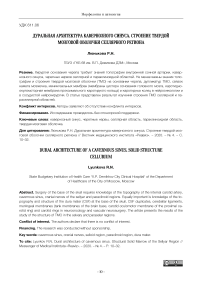Дуральная архитектура кавернозного синуса. Строение твердой мозговой оболочки селлярного региона
Автор: Люнькова Регина Николаевна
Журнал: Вестник медицинского института "РЕАВИЗ": реабилитация, врач и здоровье @vestnik-reaviz
Рубрика: Морфология. Патология
Статья в выпуске: 4 (46), 2020 года.
Бесплатный доступ
Хирургия основания черепа требует знаний топографии внутренней сонной артерии, кавернозного синуса, черепных нервов селлярной и параклиноидной областей. Не менее важны знания топографии и строения твердой мозговой оболочки (ТМО) на основании черепа, дупликатур ТМО, связок намета мозжечка, менингеальных мембран (мембраны цистерн основания головного мозга, каротидно-окуломоторная мембрана проксимального каротидного кольца) и каротидных колец в нейроонкологии и в сосудистой нейрохирургии. В статье представлен результат изучения строения ТМО селлярной и параселлярной областей.
Кавернозный синус, черепные нервы, селлярная область, параклиноидная область, твердая мозговая оболочка
Короткий адрес: https://sciup.org/143172368
IDR: 143172368 | УДК: 611.06
Текст научной статьи Дуральная архитектура кавернозного синуса. Строение твердой мозговой оболочки селлярного региона
To cite: Lyunkov R.N. Dural architecture of cavernous sinus. Structural Solid Marrow of the Sellyar Region H Messenger of Medical Instintuta «Reaviz». - 2020. - № 4. - P. 10-32.
® ®
Хирургия основания черепа требует знаний топографии внутренней сонной артерии (ВСА), кавернозного синуса (КС), черепных нервов селлярной и параклиноидной областей.
Не менее важны знания топографии и строения твердой мозговой оболочки (ТМО) на основании черепа, дупликатур ТМО, связок намета мозжечка, менингеальных мембран (мембраны цистерн основания головного мозга (ГМ), каротидно-окуломоторная мембрана проксимального каротидного кольца) и каротидных колец в нейроонкологии и в сосудистой нейрохирургии. В научной нейрохирургической литературе продемонстрирована эффективность применения транскавернозных подходов для диссекции и клипирования сложных артериальных аневризм (АА) [4, 5, 6, 8, 9, 11, 13, 16]. Например, при нормальном положении АА на уровне спинки турецкого седла (выше или ниже 5 мм) можно выполнить стандартный доступ: птериональный или подвисочный. Однако в случаях сочетания низкого положения АА верхушки БА со сложной конфигурацией аневризмы нейрохирургу необходимо осуществить адекватный подход, обеспечивающий оптимальный обзор пришеечной части и несущей АА артерии с определенным объемом хирургической свободы и возможностью надежного выключения АА из кровотока. Базальные подходы (транскавернозные или транспетро-зальные доступы) и работу на основании черепа применяют для лечения АА ВББ и АА параклиноидной локализации (АА кли-ноидного и офтальмического сегмента) [6, 11,16].
По классификации предложенной L. Sekhar (2006), в дальнейшем A. Yasuda (2008) транскавернозными считаются доступы, которые проходят через границы кавернозного синуса с деструкцией наклоненных отростков, связочного аппарата намета мозжечка (рассечение передней и задней петроклиноидной связок), менинго-переорбитальной связки в области верхней глазничной щели, колец и мембран ВСА.
Поэтому, например выполненный птериональный доступ с передней клиноидэкто-мией (резекцией переднего наклоненного отростка и части зрительной распорки) для клипирования низкорасположенных офтальмических АА с диссекцией дистального кольца, серповидной связки, зрительного чехла и мобилизацией клиноидного сегмента ВСА (С5) и устья зрительной артерии считают передним транскавернозным доступом. Рядом зарубежных нейрохирургов (L. Seoane, A. Chanda, Е. Figuerdo, М. Wanibuchi, L. Sekhar, J. Basma, A. Krisht) предложены различные варианты выполнения транскавернозных доступов. Основная идея транскавернозного подхода, как и любого другого базального доступа, заключается в уменьшении проекционного операционного угла, лежащего в плоскости операционной оси, в проекции которого обзор не доступен. В области выполнения основных хирургических действий на основании черепа, границы селлярной и параклиноидной областей, составляющие их нейроваскулярные и костные структур перекрывают обзор и препятствуют адекватному подходу к глубоким структурам основания черепа. Поэтому уменьшение проекционных углов путем резекции зоны препятствия обеспечивает адекватный обзор и клипирования труднорасположенных АА (АА с широкой шейкой) или выполнения диссекции опухолевой ткани от здоровых структур ГМ.
Строение кавернозного синуса и дуральные взаимоотношения с нейроваскулярными комплексами важны для корректной работы на основании черепа. Ключ к успешной реализации транскавернозных базальных подходов лежит в понимании дуральной архитектуры КС и детализации знаний о взаимосвязи оболочек основания черепа с сегментами и ходом ВСА, костными структурами селлярной области и отделами венозных коллекторов для профилактики кровотечения, улучшения обзора в пределах созданного хирургического промежутка или в топографо- анатомических зонах непосредственных хирургических действий (межножковая ямка, Меккелева полость, препонтинная цистерна, отделы ската и др.). Кровотечение из венозных полей кавернозного синуса и клиноидного пространства после клиноид-эктомий, резекции спинки турецкого седла и части ската остается проблемой. Несмотря на риски кровотечения, базальные доступы выполняют для диссекции опухолей основания черепа и осуществления клипирования сложных АА, технику их развивают, методы совершенствуют.
Группа японских нейрохирургов Т. Toyooka et al. (2017) прооперировали 82 пациента (61 больных со сложными АА - параклиноидной локализации и АА БАБ и 21 пациент с параселлярными опухолями). Авторы использовали экстрадуральный тем-порополярный передний транскавернозный доступ и разделили пациентов на 2 группы по применяемому методу гемостаза. В первой группе (67 больных) для гемостаза из кавернозного синуса использовали аппликации Серджисел Surgicel Fibrillar (Oxidized cellulose cotton), тампонируя место кровотечения. Во второй группе (15 больных) осуществляли введение фибринового клея (fibrin glue) в треугольники кавернозного синуса (чаще использовали треугольник Доленса и Мюллана) в количестве от 0,5 до 2,5 мл. Авторы сравнивали до и после операционные данные нейровизуализации, где анализировали топографию АА (или вовлечение в опухолевый процесс отделов кавернозного синуса и треугольников основания черепа), оценивали качество клипирования АА (или удаления опухоли), а также пред- и после операционные 3DKT-венограммы, оценивали изменения венозного кровотока по базальным венозным коллекторам. Исследование показало, что введение клея в кавернозный синус эффективно останавливает кровотечение во время диссекции его отделов. В 25 % случае менялся венозный отток по данным венограмм, но случаев отёка ГМ при введении клея не наблюдали. В приведенном ис- следовании только в одном из 82 случае после транскавернозного доступа в группе больных с гемостазом Серджиселем диагностирован отёк ГМ, пролеченный декомпрессивной краниотомией. Авторы сделали вывод, что гемостаз фибриновым клеем отделов КС через треугольники КС и основания черепа с целью гемостаза надежно и безопасно (рис. 1).
В проанализированной нами литературе, посвященной хирургии кавернозного синуса, показано, что оболочки, слагающие базальный венозный коллектор имеют сложное строение. Авторы акцентируют внимание на двухслойной структуре оболочек стенки кавернозного синуса (наружный и внутренний слои), что важно для осуществления его диссекции, безопасного рассечения и входа в его отделы через его треугольники.
Т. Kawase et al. (1996) провели анатомическое и гистологическое исследование менингеальной структуры стенок кавернозного синуса и рассмотрели клиникохирургическое значение строения КС в хирургии опухолей основания черепа. Авторы пришли к выводу, что кавернозный синус расположен в интрадуральном пространстве между надкостницей (periosteal) и менингеальной (твердой мозговой) оболочкой, доступен путем расслоения в двух областях: верхней глазничной щели (ВГЩ) и средней черепной ямки (СЧЯ). Латеральная менингеальная ТМО расщепляется хирургически важной плоскостью между «глубоким слоем» («deep layer») и полупрозрачной менингеальной оболочкой, покрывающей и защищающей черепные нервы. Кавернозный синус имеет множество менингеальных карманов, из которых Меккелева полость является крупнейшим. Адвентиция сонной артерии в пазухе непосредственно контактирует с опухолями КС. Менингеальная стенка кавернозного синуса анатомически имеет три слабых места (ТМО тонкая или отсутствует в этих точках) для инвазии опухолевой ткани: венозное сплетение вокруг верхней глазничной щели, рыхлая структура медиальной стенки вокруг гипофиза и дуральные карманы III и V черепных нервов. Авторы сделали вывод, что нейрохирургические доступы, обоснованные анатомией строения менингеальной оболочки основания черепа важны для хирургии КС (рис. 2).
Твердая мозговая оболочка СЧЯ состоит из двухслойных дуральных оболочечных структур и надкостницы, поэтому латеральные транскавернозные доступы более распространены, чем например доступы через крышу КС или задние транскавернозные доступы. Твердая мозговая оболочка ската и пирамиды имеет другую менингеальную оболочечную структуру (исследования Каваза и Ясуды).
В ретроспективном исследовании К.М. Aziz (2004 год) показана эффективность применения транскавернозных доступов при лечении менингиом сфенокавернозной, клиноидокавернозной и сфеноклиноидока-вернозной локализации у 38 пациентов. У всех больных опухоли превышали 3 см в диаметре. У 22 пациентов выполнено полное удаление опухолей, которые охватывали С4-кавернозный сегмент внутренней сонной артерии (modified Hirsch Grades 0-1). У 2 больных опухоль проникала в ВГЩ. У 14 пациентов опухоли компримировали С4ВСА (Hirsch Grades 2-4), выполнена неполная резекция.
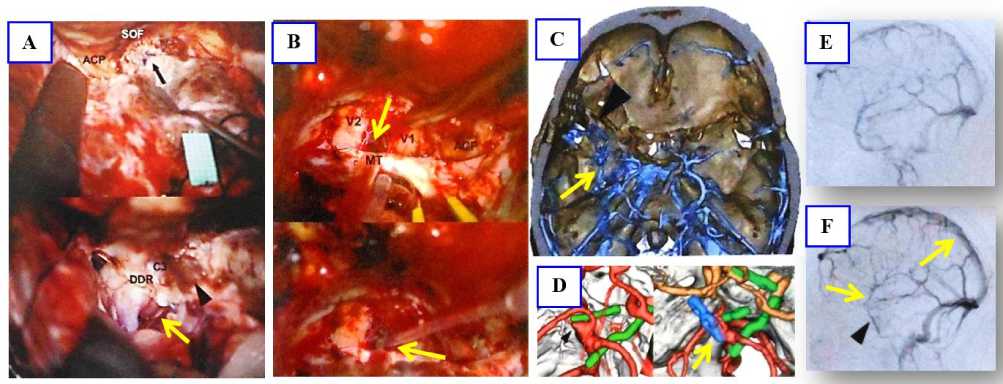
Рис. 1. Экстрадуральный темпорополярный передний транскавернозный доступ. Интраоперационные фотографии и динамическая оценка венозного оттока после операции. А - Выполнен транскавернозный доступ для клипирования правой параклиноидной АА (желтая стрелка) у больного 40 лет. Вскрыта верхняя глазничная щель (SOF), проведена резекция переднего наклоненного отростка (АСР), малого крыла клиновидной кости и зрительной распорки, рассечено дистальное дуральное кольцо (DDR), мобилизован клиноидный сегмент ВСА (СЗ), в область треугольника Доленса уложен гемостатический материал (черная стрелка); В - транскавернозный подход слева к межножковой цистерне для клипирования АА БА у больного 61 года. Основная часть доступа проведена в области дна СЧЯ, ТМО латеральной стенки кавернозного синуса расслоена, обнажен треугольник Мюллана (МТ) (желтая стрелка), через который проведена инъекция кавернозного синуса 1,0 мл фибринового клея; C-F - Нейровизуализация данных этого же больного. С - ЗОКТ-венограмма основания черепа. Стрелка на усиленном венозном рисунке основания черепа, смещение вен сфенопариетальной группы и дна СЧЯ, без дефекта оттока крови через заднее венозное поле кавернозного синуса в базилярное сплетение, функционирование верхнего каменистого синуса без нарушения оттока в бассейне глубоких вен Розенталевой группы; D - 3DKT-качества клипирования ААБА; F - до и Е - после операционные венограммы. Уменьшение оттока в системе сфенопариетального синуса и вен Сильвиевой группе на стороне оперативного вмешательства.
Венозный рисунок усилен [30]
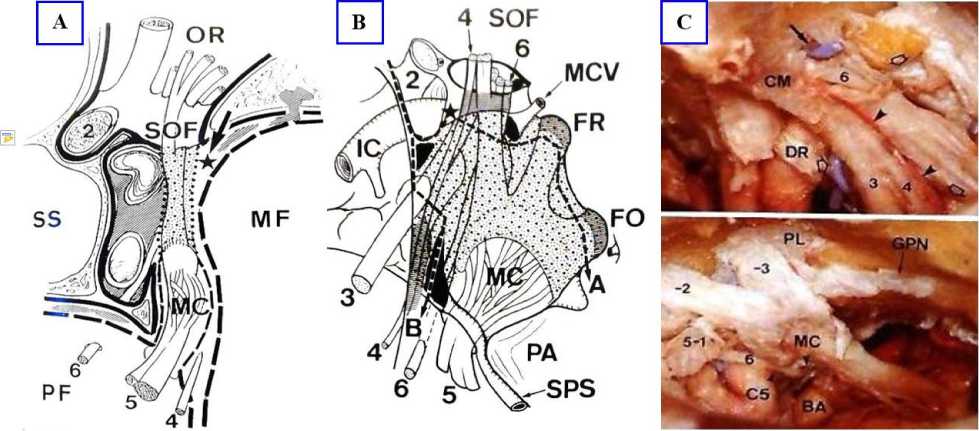
Рис. 2. Менингеальная архитектура кавернозного синуса по Kawase (1996). Схемы и анатомические препараты строения менингеальной оболочки кавернозного синуса. А - Схема аксиального среза кавернозного синуса на уровне дна СЧЯ. Черная сплошная толстая линия - периост клиновидной кости; Пунктирная линия - dura propria; Точечная линия - глубокий листок ТМО; Затемненная область - венозные поля; звезда - периостодуральная ТМО в области верхней глазничной щели (SOF), которая является местом расслоения плоскостей поверхностного и глубокого слоёв ТМО; PF - Задняя черепная яма; MF - средняя черепная яма; SS - сфеноидальный синус; МС - Меккелева полость; OR - орбита; В - Схема минимально инвазивного входа в кавернозный синус через его латеральную стенку. Область, обозначенная точками - глубокий листок ТМО; Штриховые линии А и В - линии рассечения поверхностного листка для выполнения эпидурального и субдурального входа в кавернозный синус. Серым цветом обозначены точки адгезии двух листков ТМО. Основные места венозных коллекторов КС показаны черным цветом. Субтемпоральная резекция верхушки пирамиды височной кости (РА) обеспечивает дополнительную мобилизацию тройничного нерва для подхода к задним отделам кавернозного синуса. Звезда - места начала диссекции стенки КС; IC - внутренняя сонная артерия; MCV - средняя церебральная вена; FR - круглое отверстие; FO - овальное отверстие; SPS - верхний каменистый синус; С - анатомический препарат строения КС в области ВГЩ и в области СЧЯ. Обозначения те же [16]
В статье приведены основные классические техники вскрытия стенки КС, отличающиеся местом начала расслоения латеральной стенки КС: техника вскрытия по Hakuba (начало расслоения ТМО начинают в области ВГЩ (V1)), техника Kawase (диссекцию начинают в зоне треугольника латеральной петли Lateral Loop V2-V3), техника Dolenc (расслоение начинают вдоль III нерва вдоль цистерны глазодвигательного нерва). Вход в кавернозный синус, описанный D. Parkinson (1964), в области между блоковым и первой ветвью тройничного нерва (треугольник Паркинсона) считается классическим (рис. 3, D).
Среди 38 пациентов летальность составила 0 %. Через 6-94 месяца наблюдения дефицит черепных нервов был у 6 (16 %), по
Karnofsky Performance Scale оценка составила 90 баллов у 34 пациентов (90 %). У 4 пациентов (10,5 %) развился рецидив опухоли. Авторы сделали заключение, что менингиомы кавернозного синуса степени Grades 0-1 могут быть эффективно пролечены, используя транскавернозные доступы без послеоперационной летальности.
При выполнении нейрохирургического доступа учитывают возможности расширения границ хирургических промежутков (традиционный подход). С развитием микрохирургии и более детальных знаний анатомии и топографии оперируемой области необходимо учитывать преимущества, которые возникают при дополнительной резекции костей основания черепа.
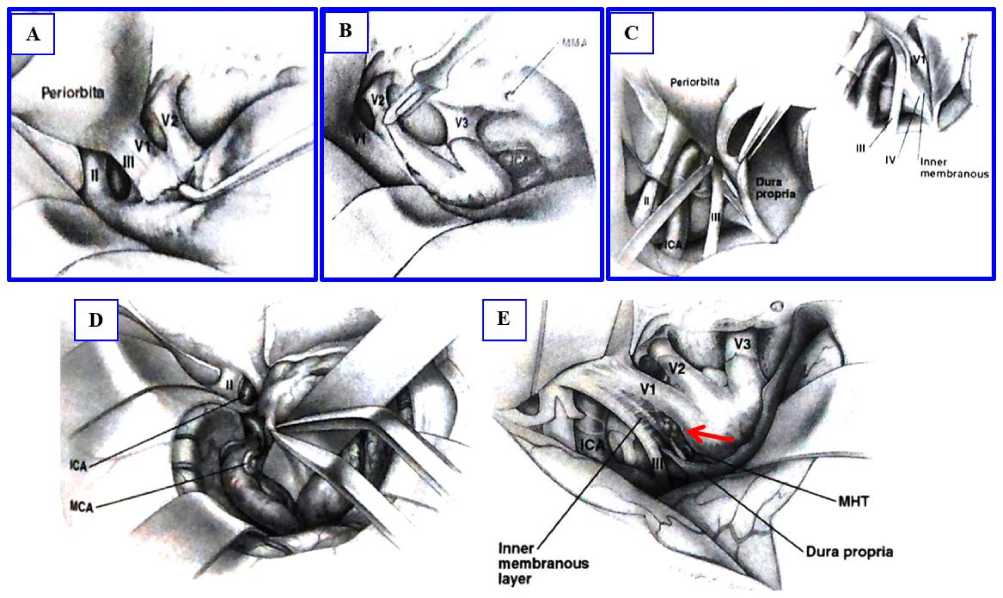
Рис. 3. Схемы классических техник входа в кавернозный синус и мобилизации наружного листка ТМО стенок КС. А. Техника Hakuba. Экстрадурально проводят острую диссекцию наружного листка ТМО латеральной стенки КС в области ВГЩ. Расслоение ТМО ведут от анеролатерального края кзади в постеромедиальном направлении; В. Техника Kawase. Выполняют экстрадуральный доступ, пересекают среднюю менингеальную артерию (ММА). Наружный листок латеральной стенки КС отслаивают от круглого и овального отверстий. ТМО расслаивают от латеральных областей к медиальным, до обнажения тройничного ганглия; С. Техника Dolenc. Выполняют интрадуральный доступ. Наружный листок (dura propria) от латеральной стенки КС рассекают вдоль глазодвигательного нерва, затем оголяют от внутреннего листка (мембраны). Расслаивают от латеральной области к медиальной; Е - транссильвиевый подход к кавернозному синусу; D - вход в кавернозный синус через треугольник Паркинсона, стрелка [2]
Диссекция ТМО основания черепа имеет определенные особенности. Дуральные оболочки вследствие их слоистого строения особенно вблизи венозных пазух или периневральных муфт можно использовать в качестве пластического материала для предотвращения кровотечения. Например, способ подворачивания рассеченной ТМО ввиде «чехла», который предложен V. Dolenc при клипировании аневризм БА и осуществлении доступа через крышу кавернозного синуса (рис. 4).
Цель исследования: изучить строение ТМО селлярной и параселлярной областей.
Материалы методы
Исследование проведено на 10 центральных отделов основания черепа: селлярная, ретро- и параселлярная области, верхние отделы ската, канал Дорелло с входящим VI нервом, Меккелева полость с V нервом, глазодвигательный треугольник с местами входа III и IV нервов, супраклиноидный отдел ВСА, зрительный нерв, оба наклоненных отростка - ПНО и ЗНО, площадку клиновидной кости (рис. 5, А, а).
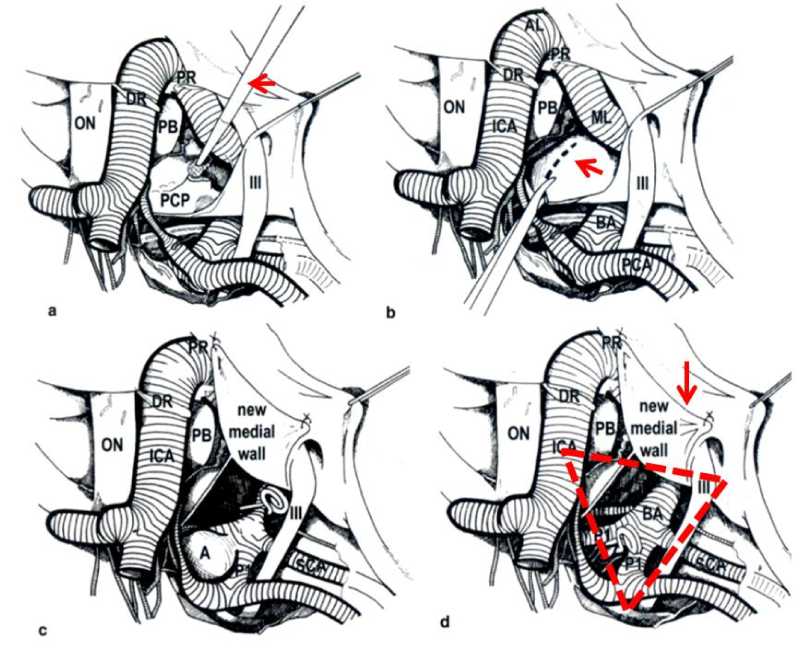
Рис. 4. Схемы транскавернозного доступа к верхушке БА через крышу кавернозного синуса по V. Do-lenc. А - резекция заднего наклоненного отростка (РСР); В - рассечение ТМО, покрывающей РСР (стрелка); С - формирование медиальной стенки кавернозного синуса путем подворачивания ТМО (стрелка); D - клипирование АА верхушки БА в расширенном мобилизацией III нерва и рассечением крыши КС каротидно-окуломоторном промежутке (штрих-треугольник) [10]
Извлечённый препарат промывался, и погружался в декальцинирующую жидкость, после того, когда кости основания черепа становились мягкими препарат разрезался четырьмя сечениями на 5 частей. Изучали строение ТМО верхушки пирамиды, складок Меккелевой полости, области ЗНО, области прилегания медиальной петли ВСА, медиальной стенки КС и капсулы гипофиза, ТМО каротидной борозды, ТМО ската и СЧЯ, строение ТМО латерального кольца ВСА и расположение передней и задней петроклиноидных связок.
Использовали методы описательной анатомии макроскопического препарата, изучали строение ТМО и цистерн основания черепа в создаваемом хирургическом пространстве выбранных сечений. Микрохирургическую анатомию ТМО КС изучали с использованием операционного микроскопа МБС-10 и цифровой видеокамеры
«Sony» HDR - СХ 560 Е. Фотографии этапов диссекции оболочек делали с 2-8 кратным увеличением.
СЕЧЕНИЕ 1. Строение Меккелевой полости
Сечение 1 проведено через латеральные отделы кавернозного синуса, область верхней глазничной щели и Меккелеву полость. Препарат захватывает область верхушки пирамиды височной кости, Меккелеву полость, V и VI нервы, канал Дорелло, латеральное кольцо ВСА, ТМО каротидной борозды, рваное отверстие, костные структуры каротидной борозды, переднюю и заднюю петроклиноидные связки (ППС и ЗПС), часть Груберовой связки, ТМО верхних отделов ската.

Рис. 5. Анатомические препараты селлярной и параселлярной областей. А, а - извлечение препарата, зона деструкции костей основания черепа стамеской; В - декальцинированный препарат, проведены сечения 4-мя линиями; С - сечение 4-й линией, показано строение складок ТМО на срезе через верхушку пирамиды височной кости и передний наклоненный отросток. Видно внутреннее однослойное покрытие ТМО области верхушки (розовая стрелка), которое в области латерального кольца СЗВСА (зеленая стрелка) переходит в область ТМО каротидной борозды (красная стрелка), в области нижнемедиальных границ соприкасается с ТМО Меккелевой полости (синяя стрелка). Желтая стрелка указывает на складки ТМО в области глазодвигательного треугольника, соприкасающиеся с медиальной петлей (ML) ВСА и областью ЗНО в месте конвергенции задней петроклиноидной и интерклиноидной связок (ЗПС)
Тройничный нерв лежит на верхушке пирамиды височной кости, которая покрыта собственной оболочкой. В области нижней границы Меккелевой полости ТМО представлена двумя слоями. Верхняя граница Меккелевой полости толстая и двуслойная. Мы разрезали довольно плотную нижнемедиальную стенку Меккелевой полости (рис. 6).
Сразу под дуральной оболочкой нижнемедиальной стенки Меккелевой полости находится VI нерв, собственная ТМО верхушки пирамиды, латеральное кольцо, от которого отходят множество отрогов к ВСА. Рваный сегмент С2ВСА окутан латеральным кольцом, волокна которого продолжаются в ТМО каротидной борозды, уходят до дистального кольца ВСА и плотно вплетаются в него и ТМО переднего наклоненного отростка, выстилают клино-идное пространство, зрительную распорку, фиброзные волокна уходят до серповидной связки и зрительного чехла медиально, ла-терально вплетаются в менинго-периорбитальную связку и оболочечную муфту круглого отверстия. На рис. 7 показаны слои ТМО Меккелевой полости.
Диссекция внутренних отделов нижнемедиальной стенки Меккелевой полости показала, что они представлены собственной оболочкой, покрывающей верхушку пирамиды височной кости, которая рыхло соединена с однослойным верхним листком нижнемедиальной стенки Меккелевой полости. У верхушки пирамиды соединительная ткань нижнемедиальной стенки Меккелевой полости переходит в латеральное кольцо, укрепляет его и формирует места прикрепления для передней и задней пет-роклиноидных связок (рис. 8).
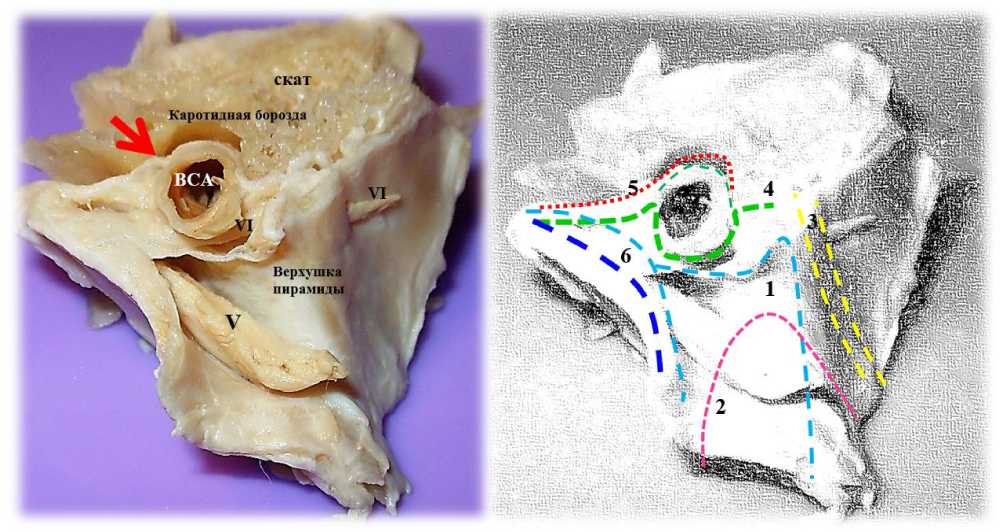
Рис. 6. Сечение 1. Меккелева полость. Слои: 1.
Нижнемедиальная стенка Меккелевой полости (одно слойный дуральный слой); 2. Собственное дуральное покрытие верхушки пирамиды височной кости, представленное одним слоем соединительной ткани, лежащим под первым дуральным слоем; 3. ТМО ската и петрокливальной щели в области нижнего каменистого синуса, покрытие представлено двумя слоями; 4. ТМО латерального кольца, представлено многослойными волокнами, которые в большом количестве находятся в боковых отделах foramen lacerum и вплетаются в ТМО каротидной борозды (стрелка); 5. ТМО каротидной борозды (один толстый слой соединительной ткани); 6. Верхнебоковая стенка Меккелевой полости, имеющая двуслойное строение (2-а слоя)

Рис. 7. Строение нижнемедиальной стенки Меккелевой полости. А - общий вид препарата; В-в Меккелеву полость введен проводник (черная стрелка), штрихами указаны линии разреза медиальной стенки Меккелевой полости. Синяя стрелка на тенториальной артерии (перерезана), верхняя часть ТМО сонного канала сливается с ТМО каротидной борозды (красная стрелка); С - вскрыта Меккелева полость и рассечена однослойная ТМО нижнемедиальной стенки Меккелевой полости, обнажено латеральное кольцо вокруг ВСА (зеленая стрелка) и собственная дуральная оболочка (ТМО) верхушки пира миды височной кости (розовая стрелка)
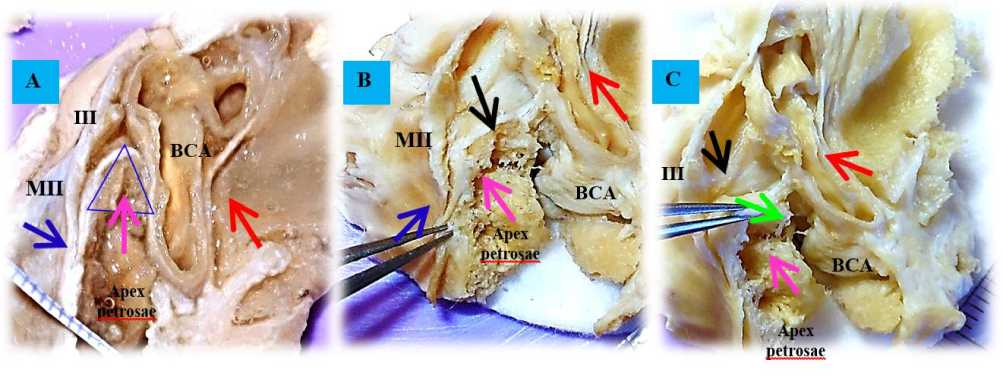
Рис. 8. Строение дурального покрытия верхушки пирамиды височной кости и поверхностный однослойный листок ТМО образующий медиальную стенку Меккелевой полости. А - Общий вид препарата срез через ПНО и верхушку пирамиды височной кости (декальцинация 2 недели). Розовая стрелка - ТМО apex petrosae толщиной 0,7-0,9 мм; Красная стрелка на ТМО каротидной борозды - 0,5 мм; Синяя стрелка на поверхностной ТМО; Синий треугольник на внутренней поверхности ТМО Меккелевой полости; В и С - препарат декальцинация - 3 недели и фиксация в 96 % р-ре этилового спирта. В - пинцет на внутреннем толстом листке, покрывающим apex petrosae со стороны ЗЧЯ. Черная стрелка на внутренней поверхности ТМО Меккелевой полости; С - пинцет на внутреннем листке, покрывающим apex petrosae в месте перехода на латеральное кольцо ВСА (зеленая стрелка). МП - Меккелева полость; ВСА - внутренняя сонная артерия
Если сопоставить рисунки 6 и 8 можно обнаружить дополнительное хирургическое рабочее пространство вдоль медиальной стенки Меккелевой полости размерами -4-5х5-7 мм (общей площадью S~35 мм2), которое можно отслоить и мобилизовать в виде лоскута. Возможные нейрохирургические манипуляции по пластики ТМО для пластики, профилактики и предотвращения кровотечения показаны на рисунке (рис. 9).
Второй внутренний листок, покрывающий верхушку пирамиды толстый до 2 мм, при резекции кости высвобождается участок ТМО размерами - 6-7х7-9 мм (дополнительное рабочее пространство обозначено треугольником (рис. 10).
Мы отметили, что наружное покрытие (менингеальный толстый слой) КС хорошо выражено. Внутренний слой слит с надкостницей и представлен одним тонким слоем. Наружный слой образует множество внут-рикавернозных шпор, выростов и трабекул, некоторые структуры напоминают «клапаны», больше представлены в первой зоне ската. Мы провели препарирование ТМО и обнаружили, что расщепление поверхност ного слоя происходит в зоне каменистых синусов. Базилярная пазуха расположена между наружным и внутренним слоями, последний же прилегает к надкостнице. Нейрохирург может отсепаровать слои, отделить и переместить внутренний слой с надкостницей со ската или он может подвернуть его или свернуть, чтобы предотвратить кровотечение. Наружный и внутренний листы образуют определенный рисунок. Утолщение менингеальных покрытий отчетливо отмечается в области петроклиноид-ных складок (связок) и вдоль них. В области ската надкостница хорошо развита, а наружный слой образует разнообразные выросты и шпоры, уходящие вглубь базилярного синуса. Отмечена сложность строения твердой мозговой оболочки в области заднего наклоненного отростка и медиальной стенки КС. Надкостница сонной борозды хорошо развита и имеет внутреннюю трабекулярную структуру, фиксирующую и связывающую ВСА. Соединительнотканные отроги ТМО каротидной борозды вплетаются в тяжи плотной соединительной ткани дистального кольца.

Рис. 9. Клеевая адгезия листков ТМО. Герметичное сопоставление менингеального покрытия и варианты приклеивания. А - одинарный подворот ТМО в виде «сэндвича», стрелкой показано направления укладки на тонкий листок ТМО, на поверхности которого распределен слой клея; В - двойной подворот ТМО, склеивание в виде «рулета», стрелкой показано направление укладки; С - укладка подвернутого рулона ТМО на более толстый соединительнотканный листок и возможное прошивание листков. Голубой цвет - фибриновый клей. Темный цвет - толстый листок ТМО, светлый цвет - тонкий листок менингеального покрытия.
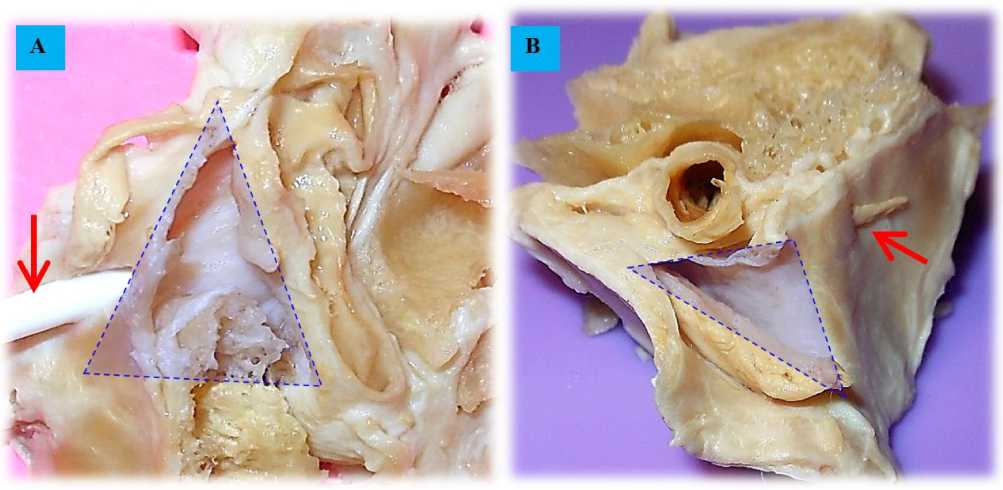
Рис. 10. Меккелева полость, нижнемедиальная стенка. Сравнение. А - срез препарата через ПНО и верхушку пирамиды височной кости (направление хирургической оси переднелатеральных доступов). В Меккелеву полость введен проводник (стрелка); В - срез через латеральные отделы КС и Меккелеву полость, медиальная стенка которой рассечена. Треугольником показана область обнаженной ТМО нижнемедиальной стенки, которую можно выкраивать лоскутом, мобилизовать и перемещать в зону резекции костей ската и петрокливальной щели в - область нижнего каменистого синуса, канала До-релло (стрелка), для предотвращения кровотечения из базилярного синуса или в область резецированных СТС и ЗНО
СЕЧЕНИЕ 4. Строение интерклино-идной связки и соединительнотканных отрогов, покрывающих Медиальную петлю ВСА
Сечение 4 проведено через ПНО-ЗНО вдоль интерклиноидной связки. Препарат захватывает область обоих наклоненных отростков, интерклиноидную связку, об- ласть фиксации ее к ЗНО, соединительнотканные отроги ТМО к медиальной петле ВСА, глазодвигательный треугольник, цистерну III нерва, каротидную борозду, область спинки турецкого седла, верхний скат, верхушку пирамиды височной кости, медиальную стенку КС, капсулу гипофиза, VI, V, III и II нервы (рис. 11).
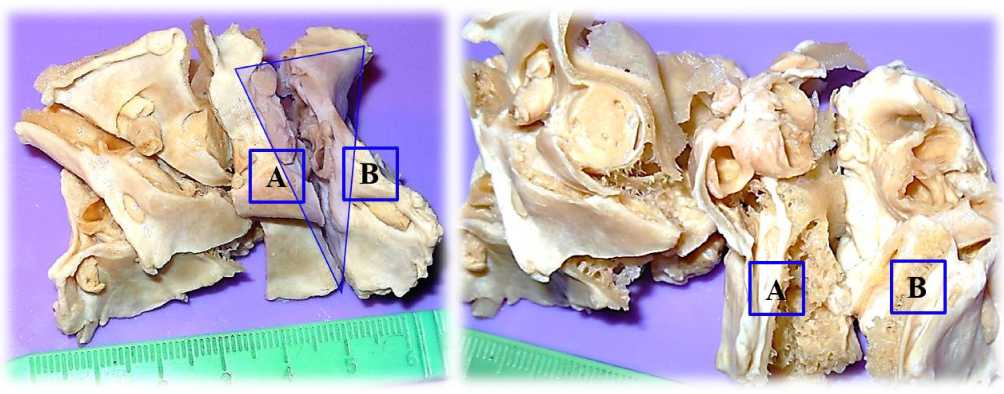
Рис. 11. Сечение 4 (треугольник), слева. Справа части рассеченного препарата развернуты: Медиальные отделы части препарата - А и его латеральные отделы - В
На препарате А показаны отделы ската и спинки турецкого седла покрытые двуслойной ТМО. В области остатков ЗНО отмечается утолщение ТМО. Это область формирования интерклиноидной и задней петроклиноидных связок. Чуть ниже на уровне спинки формируется широкий отрог ТМО, поднимающийся вверх и покрывающий медиальную петлю ВСА. В области ЗНО формируются множество соедини-тельно-тканных отрогов, фиксирующих MLBCA непосредственно к ТМО над ЗНО. Хорошо выражен на скате внутренний слой ТМО, который вверху у спинки переходит в тонкую, но прочную ткань ТМО каротидной борозды. На этом препарате также можно проследить формирование медиальной стенки кавернозного синуса.
В области стенки гипофиза ТМО каротидной борозды (толщина 0,8-1,3 мм) поднимается и покрывает его капсулу. Капсула хорошо отделяется как от медиальной ТМО КС, так и от ткани гипофиза (рис. 12, 6). Интерклиноидная связка на всем протяжении является местом образования трабекул и многочисленных тяжей для фиксации ВСА, а в области ЗНО - местом образова- ния довольно большого местами перфорированного соединительнотканного образования, которое мы назвали «капюшоном медиальной петли ВСА». Замечено, что чем больше протрузия и кривизна ML ВСА, тем больше выражен ее капюшон, что имеет значение для выполнения транскавернозных доступов с резекцией ЗНО. Общие черты строения этой области отражены на фото и схеме, где отмечена взаимосвязь ин-терклиноидной связки с основными внутри-кавернозными образованиями: трабекулами, соединительнотканными тяжами, которые связывают интерклиноидную связку с ТМО каротидной борозды, ВСА и с ТМО медиальной стенки КС. Формируется прочная сеть для крепления ВСА (рис. 12,4).
Интерклиноидная связка (ИКС) протягивается от переднего до заднего наклоненных отростков и является медиальной стенкой глазодвигательного треугольника. Большое количество соединительнотканных тяжей и трабекул на всем протяжении ИКС создает в этой области своеобразную без сосудистую зону, представленную соединительной тканью различной плотности доступную для диссекции (рис. 13).
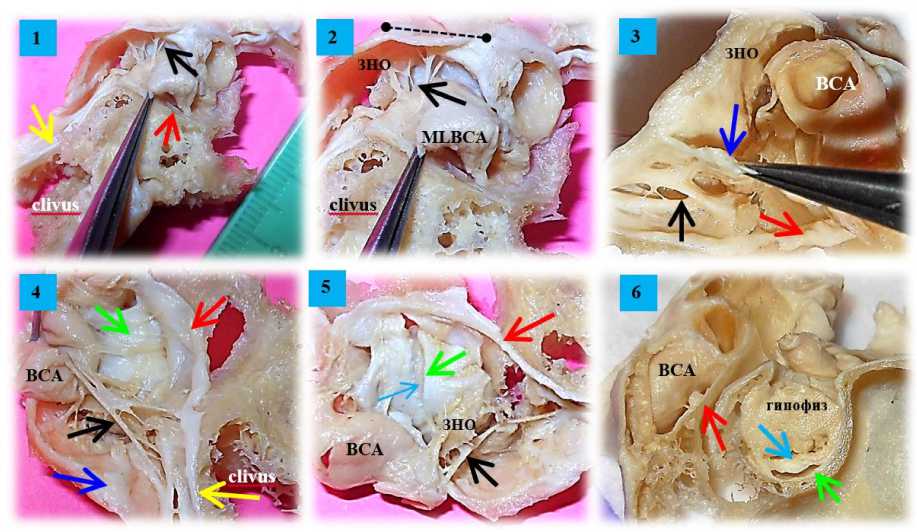
Рис. 12. Селлярная область. Сечение 4. Медиальная часть А 1. Общий вид препарата. Медиальная петля ВСА отвернута, обнажены остатки ЗНО, многочисленные соединительнотканные тяжи и отроги, которые связаны с интерклиноидной связкой, фиксирующие ВСА (черная стрелка). 2. Тоже. Увеличенный вид, часть интерклиноидной связки показана пунктиром. 3. Пинцетом отвернут капюшон ВСА (синяя стрелка), накрывающий область медиальной петли ВСА. 4. ВСА отвернута кверху, обнажены многочисленные трабекулы и прочные соединительнотканные тяжи, фиксирующие С4ВСА (кавернозный отдел) к ТМО каротидной борозды (красная стрелка) и медиальной стенке кавернозного синуса (зеленая стрелка). 5. На препарате обнажена и рассечена плотная медиальная стенка КС, видна плотная капсула гипофиза (голубая стрелка). 6. На препарате показана капсула гипофиза (голубая стрелка), медиальная стенка КС и их топография по отношению к ТМО каротидной борозды. Обозначения: Красная стрелка -ТМО каротидной борозды; Желтая стрелка на Внутреннем тонком листке ТМО ската, синяя стрелка -большой отрог ТМО области заднего наклоненного отростка и интерклиноидной связки; медиальная стенка КС - зеленая стрелка
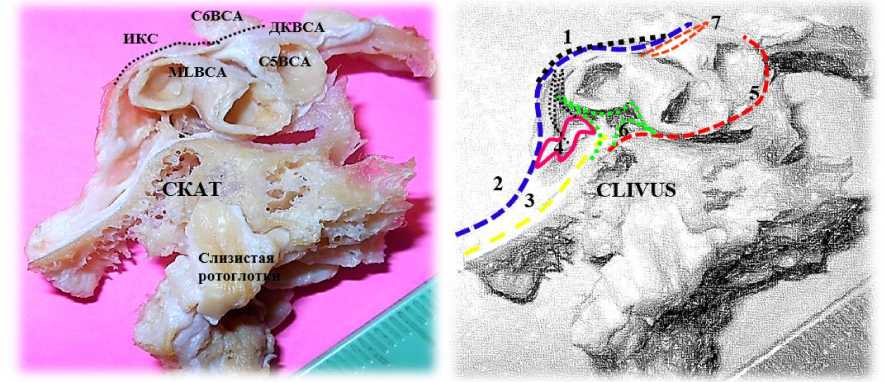
Рис. 13. Селлярная область. Сечение 4 вдоль интерклиноидной связки (связывает ПНО с ЗНО). Медиальная часть, препарат А. Слои: 1. Интерклиноидная связка (ИКС), которая связана с (4 - прочный соединительнотканный капюшон ВСА) и (6 - соединительнотканные отроги, фиксирующие медиальную петлю ВСА). 2. Поверхностный толстый листок ТМО ската, спинки турецкого седла и ЗНО. 3. Внутренний тонкий листок ТМО ската, вплетающийся соединительнотканными волокнами в ТМО каротидной борозды (5). 7. Прочные соединительнотканные волокна дистального кольца ВСА (ДКВСА). Волокна интерклиноидной связки плотно вплетаются в дистальное каротидное кольцо (черный штрих)
Препарат В демонстрирует клиновидный (С5), кавернозный (С4), рваный (СЗ) сегменты ВСА, горизонтальную часть каменистого сегмента С2ВСА, медиальную петлю ВСА (MLBCA), латеральное кольцо ВСА, верхнюю латеральную часть ската, покрытую двойной оболочкой, петрокливальную щель, верхушку пирамиды (рис. 14), ТМО каротидной борозды, каротидные кольца (ДК, ПК), цистерну III нерва. Видны участки складок и дупликатур оболочек, которые можно отслаивать, расширяя хирургические промежутки или использовать как пластический материал при выполнении транскавернозных и транспетрозальных доступов.
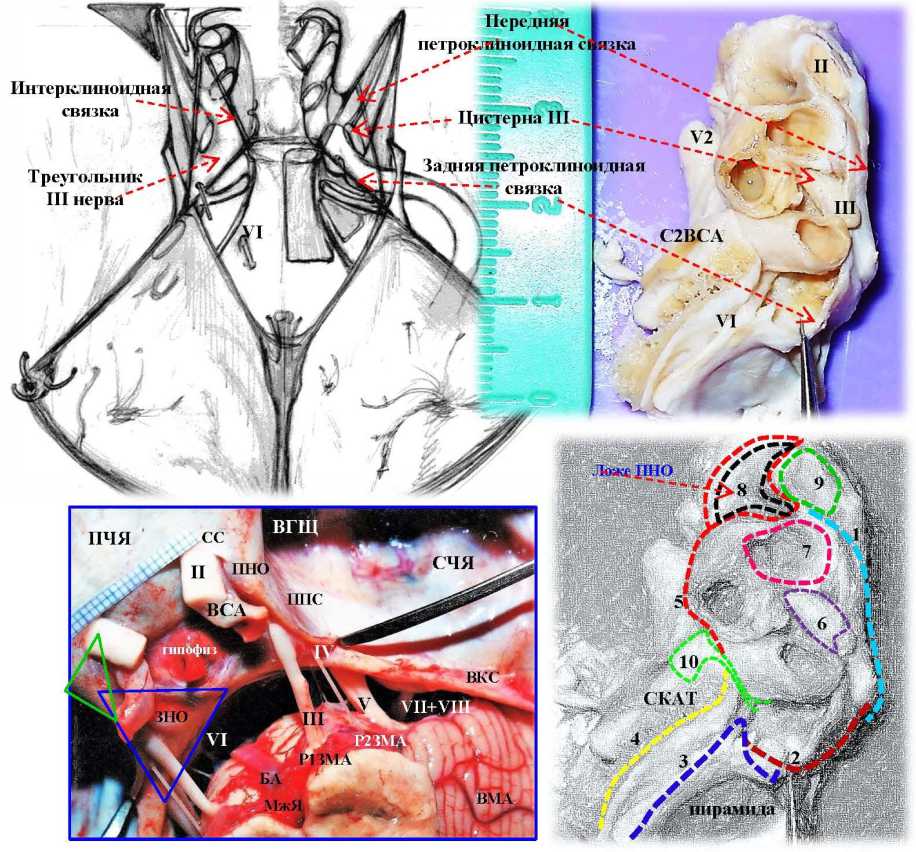
Рис. 14. Анатомический препарат селлярной, параклиноидной и параселлярной областей основания черепа Сечение 4 вдоль интерклиноидной связки от области переднего к заднему наклоненному отростку (ПНО-ЗНО). Латеральный отдел. Препарат В и схемы, Вид сверху. Слои ТМО: 1. Передняя пет-роклиноидная связка (ППС). 2. Задняя петроклиноидная связка; 3. Поверхностный толстый листок ТМО ската. 4. Внутренний тонкий листок ТМО ската, вплетающийся соединительнотканными волокнами в ТМО латерального кольца (10) и ТМО каротидной борозды (5). 6. Цистерна III нерва. 7. Прочные соединительнотканные волокна дистального кольца ВСА. 8. ТМО клиноидного пространства. 9. ТМО чехла зрительного нерва. ВКС - верхний каменистый синус; БА - базилярная артерия, СС - серповидная связка и зрительный чехол. Синий треугольник - треугольник глазодвигательного нерва, одно из ключевых мест входа в КС; ВГЩ - верхняя глазничная щель; ВМА - верхняя мозжечковая артерия; Зеленый треугольник - треугольник Доленса, который используют для передней клиноидэктомии, обнажения С5ВСА, входом в клиноидное пространство
К основным дупликатурам менингеальных оболочек, которые можно использовать для выполнении транскавернозных доступов относят участок входа III нерва в крыше КС с образованием глазодвигательной цистерны, задние отделы глазодвигательного треугольника, место конвер- генции передней и задней петроклиноидных связок (верхушка пирамиды), область ТМО каротидной борозды, передняя петрокли-ноидная связка до входа в ВГЩ с переходом в менинго-периорбитальную связку (рис. 15).
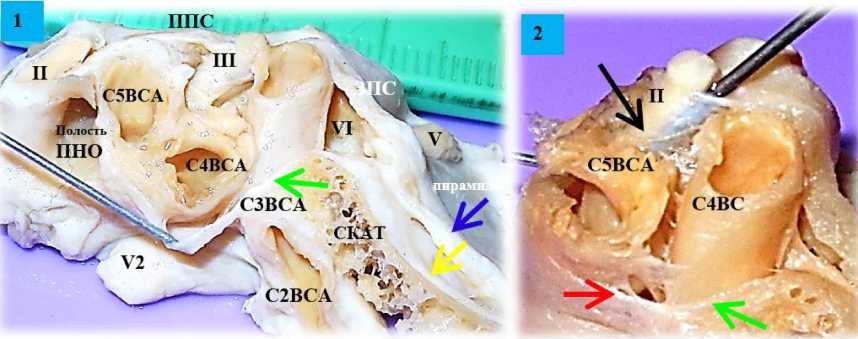
Рис. 15. Селлярная область. Сечение 4 вдоль интерклиноидной связки. Латеральная часть, препарат В. 1. Общий вид анатомического препарата, показаны передняя и задняя петроклиноидные связки (ППС и ЗПС), обнажено клиноидное пространство (полость ПНО) после растворения ПНО. Иглой отведена ТМО каротидной борозды. Синяя стрелка - поверхностный толстый листок ТМО ската. Желтая стрелка - внутренний тонкий листок ТМО ската, покрывающий затем и пирамиду височной кости. 2. Увеличенный вид. Черная стрелка на цистерне III нерва, в которую вставлен 2 мм металлический проводник на глубину 7 мм. Красная стрелка на ТМО каротидной борозды. Зеленая стрелка на латеральном кольце ВСА
Дискуссия
В научной нейрохирургической литературе обсуждают технику, методы вскрытия и рассечения ТМО отделов кавернозного синуса. Существует три основных метода входа в кавернозный синус - «Dolenc technique», вход осуществляется через крышу кавернозного синуса (область глазодвигательного треугольника, цистерна глазодвигательного нерва); «Kawase technique» через треугольник боковой петли, lateral loop, (V2-V3) и «Hakuba technique», вход в синус осуществляют через верхнюю глазничную щель,
расслаивая
менинго-
периорбитальную связку в треугольнике Мюллана [1]. Во всех случаях стратегия доступа направлена на рассечение двух слоев твердой мозговой оболочки боковой стенки КС и вход в кавернозный синус через анатомически ограниченные пространства, но допустимые для агрессивных хирургических манипуляций (резекция кости, рассечение ТМО КС) - это треугольники кавернозного синуса. С этой точки зрения знания о строении твердой мозговой оболочки кавернозного синуса, ее слоистое строение и образование внутрикавернозных трабекул, топография треугольников кавернозного синуса, расположение связочного аппарата намета и фиксирующий аппарат ВСА чрезвычайно важны. В литературе наружный и внутренний листки твердой мозговой оболочки имеют разные названия. Наружный листок чаще обозначают как «meningeal layer» «менингеальный слой» Т. Kawase [7], А. Yasuda [15, 16]. Внутренний листок или слой «inner layer» называют чаще «periosteum», периост или «надкостница» (Т. Kawase [7], J. Muto [10]), или «endosteum», «endosteal layer» - внутренний «эндост» или «эндо- стальный слой» по A. Yasuda [15, 16] -внутренняя надкостница.
Знания строения надкостницы («periosteum») в области переднего и заднего наклоненных отростков необходимы при выполнении передней и задней клиноидэк-томии, которые являются ключевыми нейрохирургическими манипуляциями, позволяющими осуществить подход, диссекцию и клипирование низкорасположенных АА в сосудистой нейрохирургии. Понимание расположения слоев ТМО, составляющие стенки КС помогает осуществить корректное расслоение ТМО латеральной стенки и крыши кавернозного синуса, пирамиды височной кости и ската при выполнении транскавернозных или транспетро- зальных доступов в нейроонкологии для удаления больших сфенопетрокливальных менингиом, опухолей кавернозного синуса или основания черепа. Техника вскрытия ТМО также важна. Кавернозный синус ограничен тремя связками: передней и задней петроклиноидными связками и интер-клиноидной связкой. Систему связок относят к связочному аппарату намета мозжечка, что важно помнить о планировании направления и объема нейрохирургического доступа (рис. 16).
Твердая мозговая оболочка КС имеет слоистое строение разной степени плотности соединительной внутрикавернозной тканью -трабекулами, нити, шпорами (рис. 17).
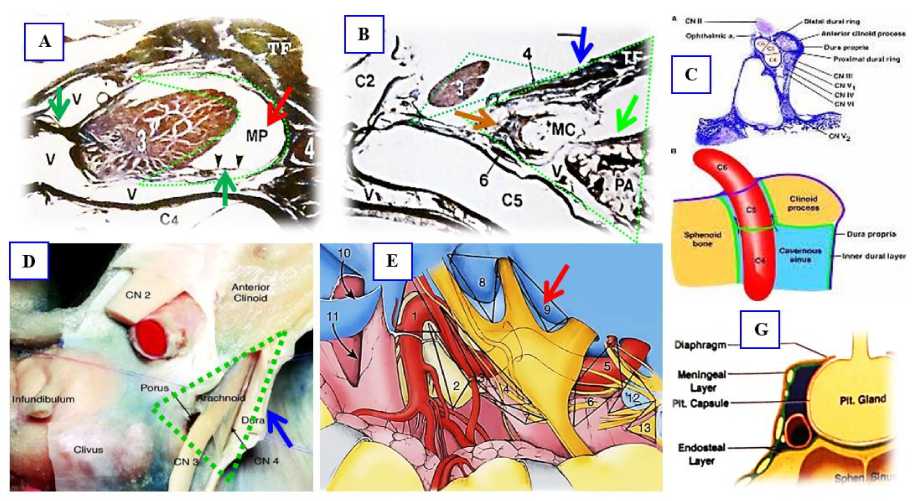
Рис. 16. Топографо-анатомическое строение кавернозного синуса. А - Гистотопографический сагиттальный срез через окуломоторную цистерну (MP - Meningeal Pocket of the III nerve, 3), демонстрирующий сложность менингеальной архитектуры крыши кавернозного синуса по Т. Kawase [7]. Красной стрелкой обозначено свободное пространство между тенториальной связкой (TF - tentorial fold) и III нервом, который свободно подвешен на связках над венозными полями (V) - зеленые стрелки; Пространство окуломоторной цистерны (МР) используют при транскавернозных доступах через крышу КС; В - Гистотопографический сагиттальный срез через пирамиду височной кости (РА) и Меккелеву полость [7]. Зеленая стрелка на надкостнице верхушки пирамиды височной кости, Синяя - наружный слой; коричневая - медиальная стенка Меккелевой полости. Зелеными штрихами обозначены свободные пространства, которые можно использовать, например, при трансмеккелевых или передних транспетрозальных доступах [16]; С - Распределение внутреннего дурального (менингеального) листка - зеленая линия вдоль костных структур параклиноидного региона (Из статьи Ким); D - Основание черепа. Аксиальный срез. Крыша кавернозного синуса вскрыта вдоль окуломоторной цистерне в области одноименного треугольника (зеленый штрих). Стрелка на отвернутой передней петроклиноидной связки [11]; Е - Треугольники кавернозного синуса [7]; G - Строение медиальной стенки кавернозного синуса по Yasuda, А [15]
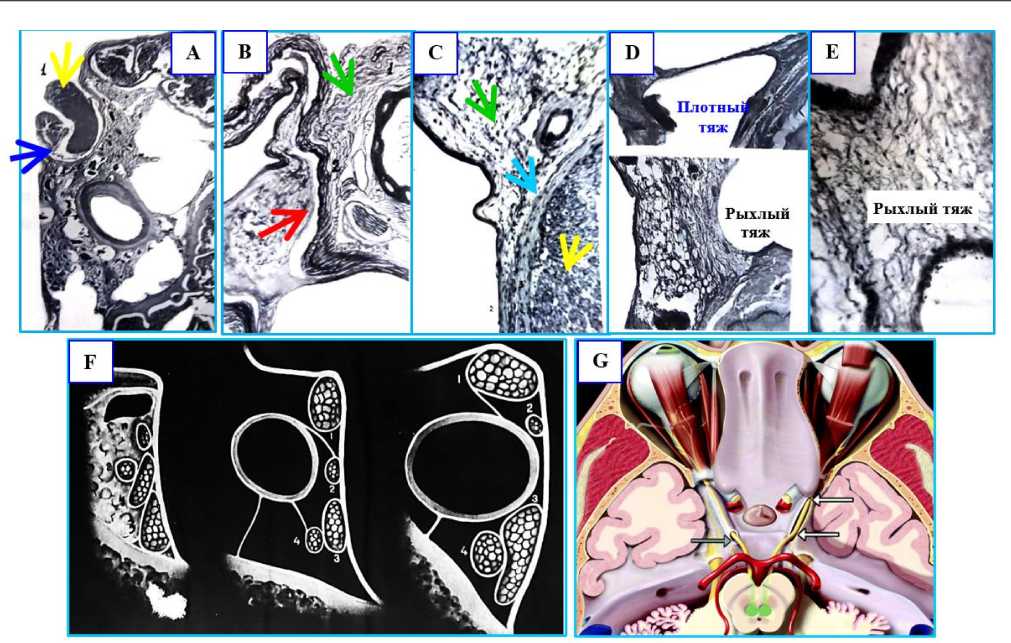
Рис. 17. Строение кавернозного синуса. А - гистотопографический срез, фото. Инвагинация ТМО КС по ходу нервных стволов (синяя стрелка). На снимке место входа в «кавернозную капсулу III нерва» (1, желтая стрелка); В - рисунок с гистотопографического препарата. Переход соединительнотканных волокон кавернозной капсулы (1, зеленая стрелка) в адвентицию артерии (2, красная стрелка); С - гистотопографический срез, фото. Взаимоотношения III нерва с собственной стенкой венозной пазухи: 1) III нерв (желтая стрелка), 2) стенка венозной пазухи, 3) соединительнотканная оболочка нерва (голубая стрелка), 4) внутрисинусовая соединительная ткань (зеленая стрелка); D - Гистотопографический срез. Различие формы внутрисинусовых тяжей; Е - Рыхлый тяж, увеличенный вид; F - Взаимоотношения нервов в передней средней и задних отделах пещеристой пазухи: 1) III нерв; 2) IV нерв; 3) V1 - первая ветвь тройничного нерва, глазной нерв; 4) VI нерв; F - Аксиальный базальный разрез крыши кавернозного синуса: клиноидный треугольник и окуломоторный треугольник (стрелка), справа вскрыта цистерна глазодвигательного нерва [11 ]
Распределение венозных областей (венозных озер или полей) в кавернозном синусе имеет свои особенности. Классически считают большими венозными полями области, окружающие медиальные отделы верхней глазничной щели и зона заднего наклоненного отростка (Ясуда, Ротон). Однако строение венозных коллекторов внутри самого синуса также специфично. В работах О.П. Большакова (1967) показано, что кавернозный синус может иметь строе ние в виде «венозной сети» с большим количеством соединительной ткани внутри синуса, либо иметь вид «лакуны», где имеются большие площади венозных озер (полей), сливающиеся с друг с другом и вливающиеся в венозные коллекторы основания черепа (рис. 18).
При входе в КС учитывают особенности его анатомического строения и производят в местах допустимых для входа в КС - его треугольниках (рис. 19).
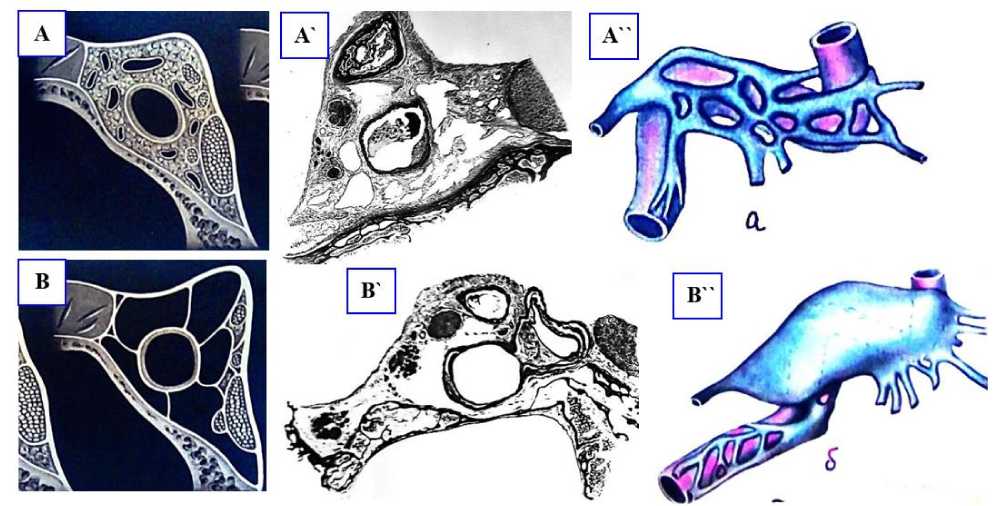
Рис. 18. Различия в строении и крайние формы строения кавернозного синуса. А - Схема, гистологический срез, фото и рисунок строения кавернозного синуса в виде сплетения; В - строение в виде лакуны
Для доступов через крышу КС важна топография и размеры оболочечных структур в области входа III нерва, формирующих цистерну глазодвигательного нерва, а также размеры глазодвигательного треугольника, ограниченного конвергенцией петроклиноидных связок намета мозжечка и образующего крышу КС. При выполнении антеролатеральных базальных доступов со вскрытием КС важна протяженность верхней глазничной щели, топография менинго-переорбитальной связки и передней петро-клиноидной связки.
В месте, где выражена слоистая структура, возможно смещение отделенных слоев и внутрикавернозной ткани для достижения коллапса вен и клапанного эффекта. В случае развитого внутреннего слоя («надкостницы») можно путем диссекции отсоединить слой («periosteum»), а затем заправить его для предотвращения кровотечения или использовать фибриновые клеевые композиции. Для профилактики кровотечений из кавернозного синуса в настоящее время используются современные и эффективные средства, различные гемостатические материалы и методы их введения. Например, в комментариях к статьям McLaughlin N. (Р-23) [2] and Y. Kim (Р179) [8] LN. Sekhar написал, что он использовал инъекцию фибринового клея в венозное поле кавернозного синуса с хорошим гемостатическим эффектом. Цитата: «This transcavernous transapical approach becomes much easier owing to the use of the fibrin glue, and ultrasonic bone curette» L. Sekhar (2014), Seattle, Washington. LN. Sekhar также отметил, что транскавернозные доступы наиболее эффективны для подхода и клипирования сложных АА труднодоступной локализации, например для низко расположенных АА верхушки БА (более чем на 5 мм ниже спинки турецкого седла). Часть из них автор оперировал через расширенные транскавернозные подходы с открытием Меккелевой полости, резекции верхушки пирамиды височной кости и выполнением заднего транскавернозного доступа с интрадуральной резекцией верхушки пирамиды височной кости с целью улучшения осмотра и увеличения операционной свободы хирургических манипуляций.
Medial group
The names of the triangles in this study
Superoposterior triangle
The names of the triangles in
Lateral group
Posterior group
Superior triangle
Middle triangle
Inferior triangle
Anteromedial triangle
Anterolateral triangle
Posterolateral triangle
Posteromecbal triangle
Lateral triangle
MerSal triangle
(V) Anterior clinoid process ------------
(V) Posterior dinoid process
(V) Apex of petrous part
(B) Optic nerve
(8) Oculomotor nerve before entering the superior orbital fissure
(B) Dural fold between dural entries of optic and oculomotor nerves
(B) Oculomotor nerve
(B) Trochlear nerve
(B) Dural fdd between dural entries of oculomotor and trochlear nerves
(B) Trochlear nerve
(B) Ophthalmic nerve
(B) Dural fold between dural entries of trochlear and ophthalmic nerves
(B) Ophthalmic nerve
(B) Maxifery nerve
(B) Between the superior orbital fissure and the foramen rotundum
(В)Ма»1ату nerve
(B) Mandibular nerve
(B) Between the foramen rotundum and foramen ovate
(B) Mandixitar nerve
Pl Greater petrosal nerve
(B) Between foramen ovale and hiatus of greater petrosal nerve
(9 Trigeminal gangion
(B) Greater petrosal nerve
(B) Between hiatus of у eater petrosal nerve and apex of petrous part
(V) Dural entry of trochlear nerve
(V) Dural entry of abducens nerve
(V) Apex of petrous part
(V) Dural entry of trochlear nerve
(V) Dural entry of abducens nerve
(V) Posterior dinoid process
Oculomotor triangle (2)
Anteromedial triangle (2), dinoidal triangle (6), Dolenc’s triangle (22)
Paramedal triangle (2), Paramedan triangle (5), Supratrochlear triangle (6)
Superolateral triangle (23), iifratr ochtear triangle (6)
Parkinson's triangle (2)
Anterolateral triangle (2), Muta's triangle (3)
Lateral triangle (2)
Posterolateral triangle (2), Glasscock's triangle (2)
Posteromedial triangle (2), Kawase's trianc^e (2)
Inferolateral triangle (2)
Irrferomedial triangle (2)
bst. dinoid process
art petrosal nerve
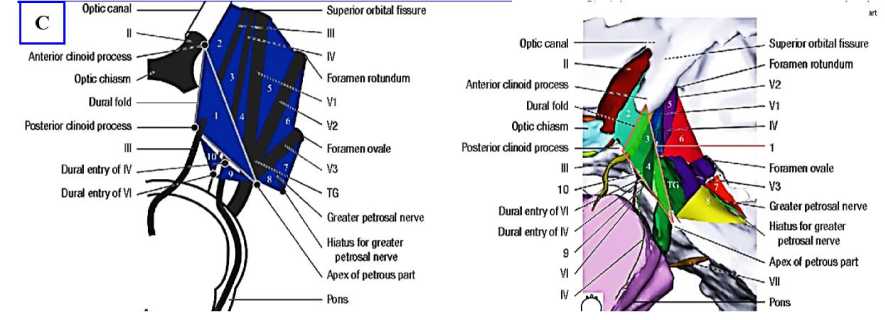
Рис. 19 Треугольники кавернозного синуса. А - нейрохирургическая классификация треугольников кавернозного синуса; В - анатомический препарат кавернозного синуса. Уровни срезов анатомического препарата кавернозного синуса продемонстрированы на центральной схеме; С - топография треуголь
ников кавернозного синуса по отношению к черепным нервам и костным структурам селлярного и параселлярного регионов: 1 = superoposterior triangle (глазодвигательный треугольник); 2 = superior triangle; 3 = middle triangle; 4 = inferior triangle; 5 = anteromedial triangle; 6 = anterolateral triangle; 7 = posterolateral triangle; 8 = posteromedial triangle; 9 = lateral triangle; 10 = medial triangle; II = optic nerve; III = oculomotor nerve; IV = abducens nerve; V1 = ophthalmic nerve; V2 = maxillary nerve; V3 = mandibular nerve; TG = trigeminal ganglion [6]
Выводы проведенного исследования
-
1. При изучении препаратов отмечено, что топографическое распределение и строение слоев твердой мозговой оболочки, покрывающей параселлярную область довольно сложное. Отмечено утолщение структуры стенок КС в области непосредственного контакта с кольцами и петлями ВСА. Дуральная оболочка над областью медиальной петли ВСА имеет многочислен
-
2. Поверхностный листок (наружное дуральное покрытие) крыши кавернозного
-
3. При диссекции ТМО верхушки пирамиды и нижнемедиальной стенки Меккелевой полости обнаружено, что верхушка пирамиды покрыта внутренним собственным тонким листком ТМО, рыхло связанным с поверхностным толстым листком ТМО. При выполнении интрадуральной резекции верхушки пирамиды со стороны Меккелевой полости можно получить преимущество ввиде дополнительного участка соединительной ткани (ТМО обозначена треугольником рис. 21, В), которую можно переместить (отвернуть, подогнуть), тем самым предотвратить кровотечение.
-
4. Имеются особенности строения ТМО каротидной борозды, которая представлена плотной соединительной тканью, которая медиально непосредственно переходит
в ТМО синуса, ренним области
ные внутрисинусные соединительнотканные отроги и трабекулы, фиксирующие ВСА к крыше и стенкам кавернозного синуса. Твердая мозговая оболочка над самой вершиной ЗНО почти однослойная (оба слоя прочно склеены друг с другом), диссекция слоев затруднена. Резекция ЗНО вместе с частью спинки турецкого седла образует двухслойный карман.
синуса смешивается с соединительной тканью трех петроклиноидных связок фиксирующего аппарата намета мозжечка и представляет собой треугольник, ТМО которого натянута между тремя вершинами -передний и задний наклоненные отростки и верхушка пирамиды височной кости. Это важный треугольник крыши КС - глазодвигательный треугольник. Глубокий листок представлен фиброзным листком ТМО ската, который поднимается вверх и сливается с медиальной стенкой КС (селлярной ТМО) и с соединительнотканным покрытием каротидной борозды. В области ЗНО много дополнительных фиброзных образований, которые крепятся к внутренней поверхности петроклиноидных связок, являясь внут-рикавернозными отделами связочного аппарата ВСА - это трабекулы, «полуклапаны», «капюшоны». В области верхних отделов ската между листками ТМО (поверхностным и глубоким) находится много соединительнотканных трабекул и клапанов. Применительно к базальной хирургии это имеет практическое значение, например создание условий для гемостаза и соответственно контроль венозного кровотечения (рис. 20).
медиальной стенки кавернозного Внизу эта ТМО сливается с внут-листком, покрывающим скат, а в рваного отверстия укрепляет во- локна латерального кольца ВСА. От ТМО каротидной борозды отходят многочисленные отроги-трабекулы к медиальной петле и кавернозному идной связке и ЗНО.
отделу ВСА, интерклино-оплетают весь периметр

Рис. 20. Внутрикавернозные соединительнотканные образования. Анатомические препараты селлярной области. 1,2- трабекулы и клапаны показаны черной стрелкой, желтая стрелка на внутреннем листке ската, голубая стрелка на соединительнотканном отроге ТМО («капюшон ВСА»), который крепится к интерклиноидной связке и ЗНО, синяя стрелка на ТМО спинки турецкого седла с внутренней поверхности, далее эта ТМО переходит в ТМО медиальной стенки кавернозного синуса и ТМО каротидной борозды; 3 - транскавернозный доступ, резекция ЗНО, обнажена ТМО спинки турецкого седла. По пери
метру ЗНО образуется двуслойный карман (зеленая стрелка), который можно отвернуть в сторону ската для остановки кровотечения из базилярного синуса
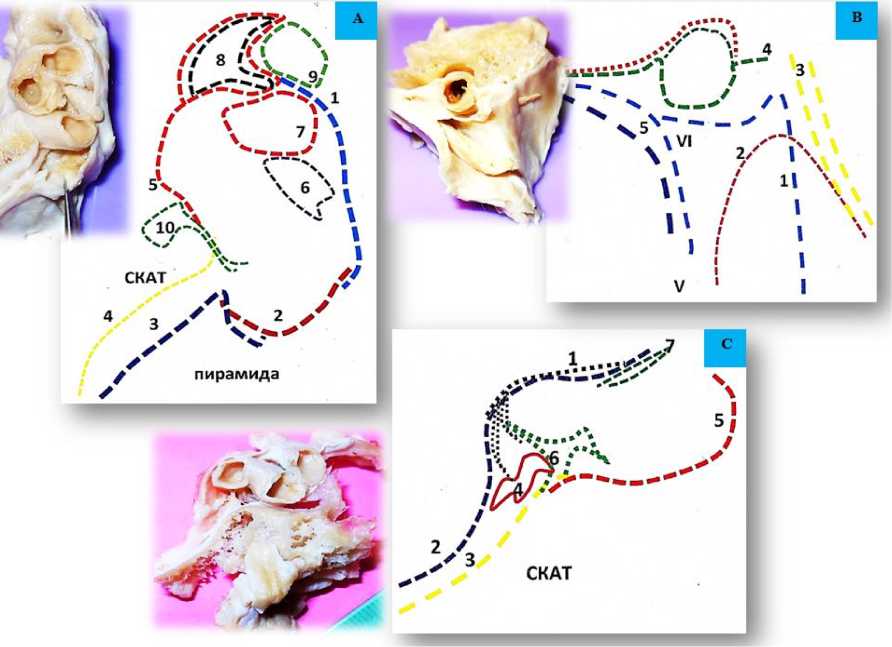
Рис. 21. Срезы. Препарат и схема. А - срез вдоль интерклиноидной связки (латеральная часть). Слои ТМО: 1. Передняя петроклиноидная связка. 2. Задняя петроклиноидная связка. 3. Покрытие ската (поверхностный толстый слой ТМО). 4. Тонкий слой ТМО ската, вплетающийся в латеральное кольцо ВСА (10) и покрытие каротидной борозды (5). 6. Цистерна глазодвигательного нерва. 7. Дистальное кольцо ВСА. 8. Дуральное покрытие клиноидного пространства. 9. Дуральный чехол зрительного нерва. В - срез Меккелевой полости. Слои ТМО: 1. Нижнемедиальная стенка Меккелевой полости (поверхностный дуральный слой). 2. Собственное покрытие верхушки пирамиды височной кости (один слой соединительной ткани), лежащий под поверхностным слоем. 3. Двуслойная кливальная ТМО в области петрокливальной щели (нижний каменистый синус). 4. Соединительная ткань латерального кольца LLBCA. 5. Однослойное соединительно-тканное покрытие каротидной борозды. 6. Верхне-медиальная стенка Меккелевой полости (двуслойное толстое покрытие). С - срез вдоль интерклиноидной связки (медиальная часть). Слои ТМО: 1. Интерклиноидная связка с множеством соединительнотканных отрогов (6, 4), поддерживающих медиальную петлю MLBCA. 2. Поверхностный толстый листок ската, ЗНО и СТС. 3. Внутренний дуральный листок ската, который охватывает соединительнотканные волокна каротидной борозды (5). 7. Фиброзные соединительнотканные волокна дистального кольца ВСА
Список литературы Дуральная архитектура кавернозного синуса. Строение твердой мозговой оболочки селлярного региона
- Abla А.А. et al. Current treatment strategies for cavernous internal carotid artery aneurysms // World Neurosurg. - 2014. - Vol. 82. - P. 994-995.
- Aziz, K.M.A. Large Sphenoid Wing Meningiomas involving the cavernous sinus: Conservative surgical strategies for better functional outcomes // Neurosurgery. - 2004. - Vol. 54, № 6. - P. 1375-1384.
- Basma J. Mobilization of the transcavernous oculomotor nerve during basilar aneurysm surgery: Biomechanical base for better outcome // Operative Neurosurgery. - 2014. - Vol. 10, №1. - P. 106-115.
- Bouthillier A et al. Segments of the internal carotid artery: a new classification // Neurosurgery. - 1996. - Vol. 38. - P. 425-32.
- Chanda A. et al. Anatomical study of the orbitozygomatic transsellar-transcavernoustransclinoidal approach to the basilar artery bifurcation // Neurosurg. - 2002. - Vol. 97, № 2. - P. 151-160.
- Chung В. et al. Ten Triangles around Cavernous Sinus for Surgical Approach, Described by Schematic Diagram and Three Dimensional Models with the Sectioned Images // Korean Med Sci. - 2016. - Vol. 31. - P. 1455-1463
- Curey S. et al. Validation of the superior interhemispheric approach for tuberculum sellae meningioma: clinical article // Neurosurg. - 2012. - Vol. 117. - P. 1013-1021.
- Dolenc W et al. Cavernous Sinus: Developments and Future Perspectives. - New York: Springer, 2009.
- Dolenc W. Anatomy and Surgery of the Cavernous Sinus. - New York: Springer-Verlag, 1989.
- Dolenc, V.V. Microsurgical anatomy and surgery of the central skull base. - New York, Wien. Springer, 2003 - 384 p.
- Everton K.L. et al. The Oculomotor Cistern: Anatomy and High-Resolution Imaging // American Journal of Neuroradiology August. - 2008. - Vol. 29 (7). - P. 1344-1348.
- Federative Committee on Anatomical Terminology. Terminologia Anatomica: International Anatomical Terminology. - Stuttgart: Thieme, 1998.
- Figueiredo E.G. Anatomical and quantitative description of the transcavernous approach to interpeduncular and prepontine cisterns // Neurosurg. - 2006. - Vol. 104, № 1. - P. 957-964.
- Fujimoto Y et al. Pterional transcavernous approach for large basilar top aneurysm: significance of the exposure of Dolenc's triangle // Surg Cereb Stroke. - 1992. - Vol. 20. - P. 191 -195.
- Isolan G.R. et al. Microsurgical anatomy of the cavernous sinus: measurements of the triangles in and around it. // Skull Base. - 2007. - Vol. 17. - P. 357-367.
- Kawase T. Meningeal architecture of the cavernous sinus: clinical and surgical implications // Neurosurg. - 1996. - Vol. 39, № 3. - P. 527-536.
- Kim, J.M. Microsurgical Anatomic Features and Nomenclature of the Paraclinoid Region [Text] / J.M. Kim, A. Romano // Neurosurgery. - 2000. - Vol. 46, № 3. - P. 670-682.
- Kim J.S. et al. The pterional approach and extradural anterior clinoidectomy to clip paraclinoid aneurysms // Cerebrovasc Endovasc Neurosurg. - 2013. - Vol. 15. - P. 260-266.
- Kim Y. Quantitative study of the opticocarotid and carotid-oculomotor windows for the interpeduncular fossa, before and after internal carotid artery mobilization and posterior communicating division // Operative Neurosurgery. - 2015. - Vol. 11, № 1. - P. 162-180.
- Krisht A.F. Surgical Clipping of Complex Basilar Apex Aneurysms: A Strategy for Successful Outcome Using the Pretemporal Transzygomatic Transcavernous Approach // Operative Neurosurgery. - 2005. - Vol. 56, Suppl. 2. - P. 261-273.
- Krisht A.F. Transcavernous approach to diseases of the anterior upper third of the posterior fossa // Neurosurgical Focus. - 2005. - Vol. 19, № 2 (E). - P. 1 -10.
- McLaughlin N. Extended subtemporal transtentorial approach to the anterior incisural space and upper clival region: experience with posterior circulation aneurysms // Operative Neurosurgery. - 2014. - Vol. 10, № 1. - P. 15-24.
- Muto, J. Meckel's Cave Tumors: Relation to the meninges and minimally invasive approaches for surgery anatomic and clinical studies // Operative Neurosurgery. - 2010. - Vol. 67, № 1. - P. 291-299.
- Park H.S. et al. Whole courses of the oculomotor, trochlear, and abducens nerves, identified in sectioned images and surface models // Anat Rec (Hoboken). - 2015. - Vol. 298. - P. 436-443.
- Park J.S. et al. A proposal of new reference system for the standard axial, sagittal, coronal planes of brain based on the serially-sectioned images // Korean Med Sci. - 2010. - Vol. 25. - P. 135-141.
- Park J.S. et al. Sectioned images of the cadaver head including the brain and correspondences with ultrahigh field 70 T MRIs // Proc IEEE. - 2009. - Vol. 97. - P. 1988-1996.
- Samii M. Surgical management of to meningiomas originating in Meckel's Cave // Neurosurg. - 1997. - Vol. 41, № 4. - P. 767-774.
- Sekhar L.N. Atlas of neurosurgical techniques. - Brain New York, Stuttgart: Thieme Medical, 2006. - 1074 p.
- Shin D.S. et al. Portable document format file showing the surface models of cadaver whole body // Korean Med Sci. - 2012. - Vol. 27. - P. 849-856.
- Тоуоока T. et al. Effect of Fibrin Glue Injection into the Cavernous Sinus for Hemostasis during transcavernous surgery jn the Cerebral Venous Draining system // Operative Neurosurgery. - 2017. - Vol. 13. - P. 224-231
- Tripathi М. et al. Quantitative analysis of the Kawase versus the modified Dolenc-Kawase approach for middle cranial fossa lesions with variable anteroposterior extension // Neurosurg. - 2015. - Vol. 123. - P. 14-22.
- Van Loveren H.R. et al. The Dolenc technique for cavernous sinus exploration (cadaveric prosection). Technical note // Neurosurg. - 1991. - Vol. 74. - P. 837-844.
- Wanibuchi, M. / M. Wanibuchi, A.H. Friedman, T. Fukushima // Photo Atlas of Skull Base Dissection / ed. M. Wanibuchi. - New York: Thieme Medical, 2009. - P. 166-206, 247.
- Wanibuchi, M. Trigeminal Schwannomas: Skull Base Approaches and Operative results in 105 Patients // Operative Neurosurgery. - 2012. - Vol. 70, Suppl. 1. - P. 132-144.
- Watanabe A et al. Anatomical variations of the ten triangles around the cavernous sinus // Clin Anat. - 2003. - Vol. 16. - P. 9-14.
- Yasuda A. Microsurgical anatomy and approaches to the cavernous sinus // Neurosurg. - 2008. - Vol. 62, № 6. - Suppl. 3. - P. 1240-1263.
- Yasuda A. The medial wall of the cavernous sinus Microsurgical anatomy // Neurosurg. - 2004. - Vol. 55, № 6. - P. 179-190.
- Yoon B.H. et al. Meningeal layers around anterior clinoid process as a delicate area in extradural anterior clinoidectomy: anatomical and clinical study // Korean Neurosurg Soc. - 2012. - Vol. 52. - P. 391-395.

